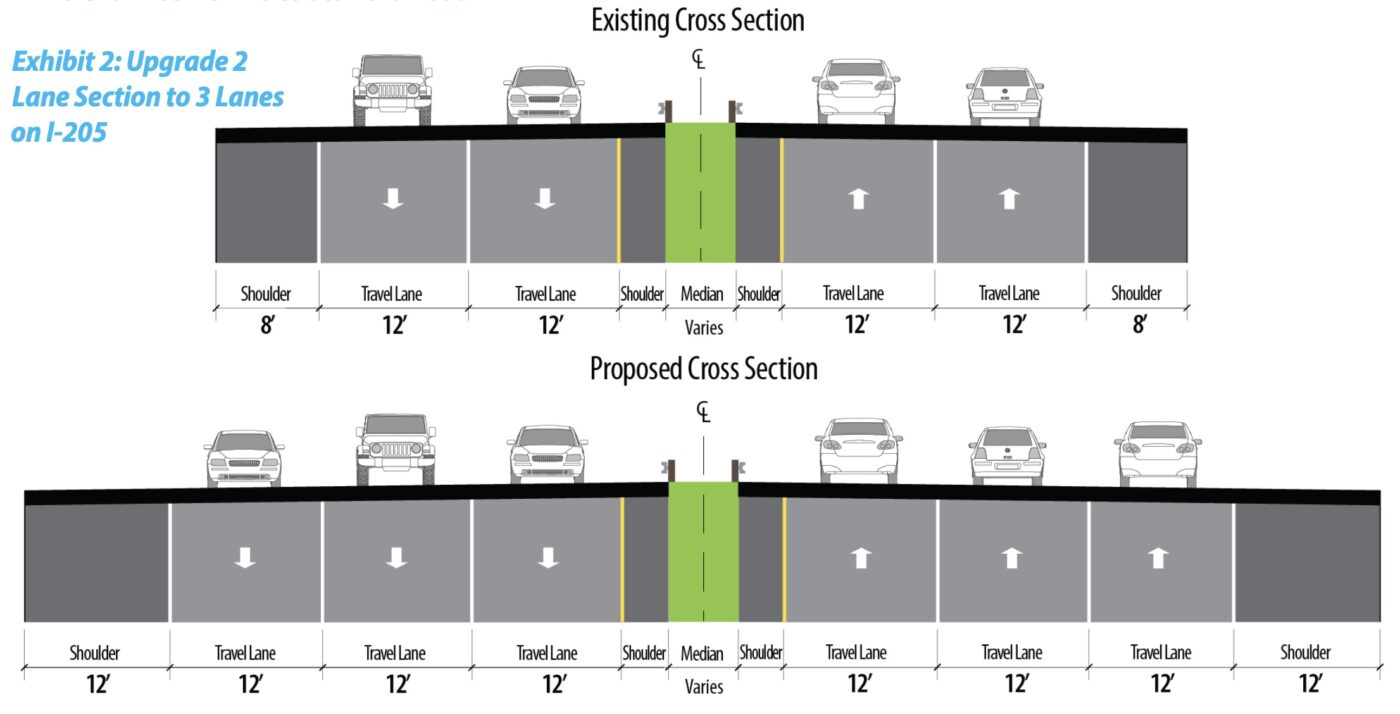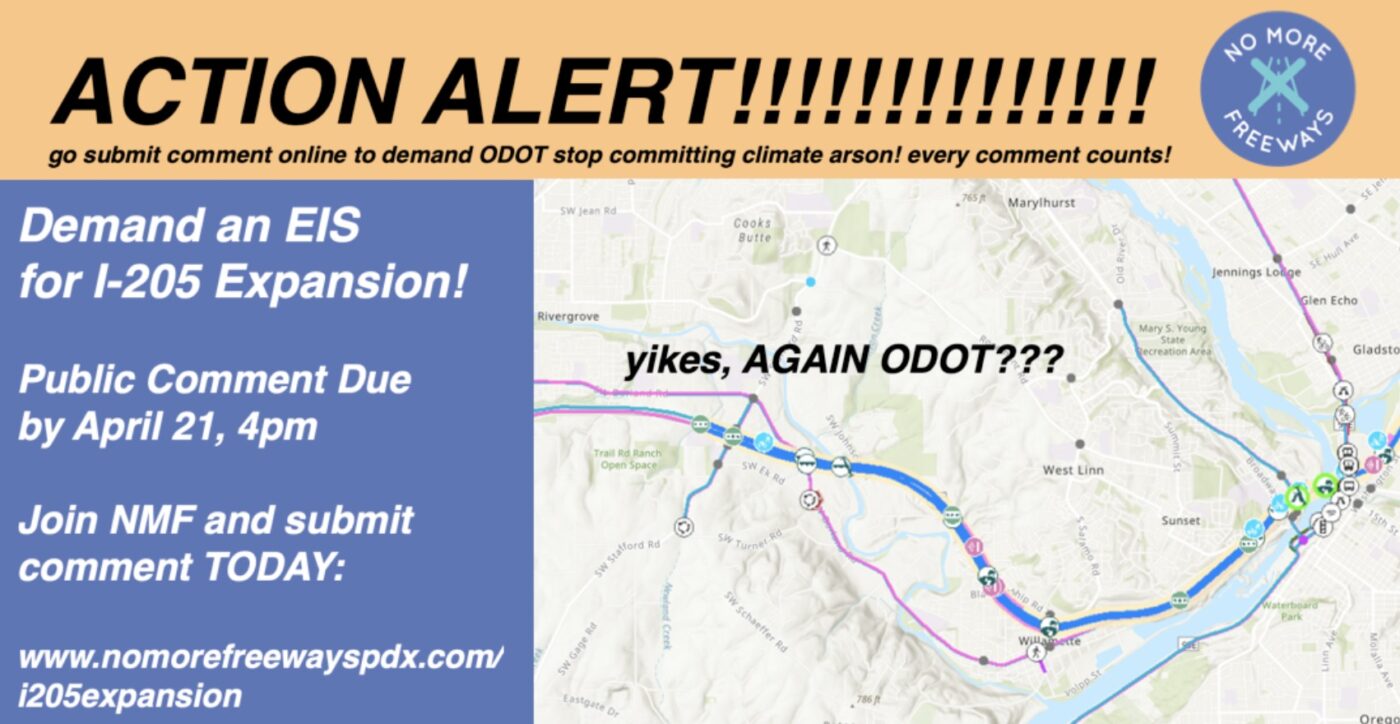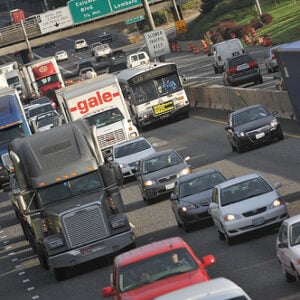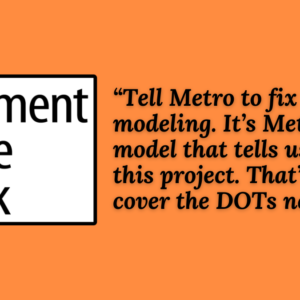Portland-based advocacy group No More Freeways has become a household name among transportation reformers region-wide for their work in opposing the State of Oregon’s I-5 Rose Quarter project. Now the group has turned to another front in their freeway fight: An expansion of I-205 in Clackamas County.
ODOT’s plan for Phase Two of the “I-205 Improvements” project (Phase One is to build a new, wider Abernethy Bridge over the Willamette River) is to add one additional freeway lane for a seven-mile stretch between Highway 42 and Stafford Road.
NMF has launched a campaign urging supporters to comment on the project, which they say will add between 79 and 109 million vehicle miles traveled (VMT) a year — that’s about 1.2 million metric tons of carbon by their estimate. “This is directly in conflict with Oregon’s aggressive targets for reducing carbon emissions, prioritizing investments in safer streets, or ensuring ODOT has the resources to invest in basic seismic retrofits for the 700 bridges across the state that need repair,” writes NMF on their website.
When we first reported on this project in 2017, ODOT referred to it as “operational enhancements” and estimated the cost to be $450 million. Today that number has skyrocketed to $515 million (that’s in addition to the $544 million for the Abernethy Bridge in Phase One). By the time payments are due and this phase of the project gets built, it will likely be even higher, since Federal Highway Administration data shows that highway construction costs have risen 50% in the last two years alone.
“The addition of new lanes to I-205 will have no tangible impact on congestion… either on the freeway itself or on nearby local roads.”
– USPIRG
ODOT is already overextended trying to pay for a slew of freeway expansions across the state. In 2021 they had to go back to the legislature to pass House Bill 3055. That bill, which passed over staunch opposition from NMF and other groups, increased ODOT’s short-term borrowing (bonding) authority from $100 million to $600 million. The bill also earmarked $30 million of those funds to this phase of the I-205 project specifically. ODOT is also working feverishly on a tolling plan that is expected to help pay for this project.
According to ODOT, the project is needed because it’s the last remaining segment of I-205 in Oregon that isn’t already three lanes in both directions. They want to widen it to address “multiple lengthy bottlenecks” that if left unchecked could, “significantly impact state and regional economic activity.” They also cite safety benefits with the new lanes due to fewer weaving movements that will, “allow traffic to flow more freely and reduce the number of crashes.”
The U.S. Public Interest Research Group (PIRG) a coalition of nonprofits that advocate around consumer protection, public health and transportation issues, has called this project a “boondoggle.” “The addition of new lanes to I-205 will have no tangible impact on congestion… either on the freeway itself or on nearby local roads,” they wrote late last year.
ODOT is currently conducting an environmental assessment as part of the federally obligated analysis that must be completed prior to receiving tolling authority.
In addition to concerns about VMT, emissions, and a lack of fiscal responsibility, NMF feels ODOT should conduct a more thorough environmental impact study before moving forward with any plans. They also believe if ODOT were to toll first, they might find that the additional lane isn’t necessary.
“The legal somersaults and fingers-on-the-scale to justify patently absurd numbers about cost benefit analysis and traffic projections would be laughable if the consequences we’re so dire,” NMF writes on their action alert.
If you want to share a comment on this project’s EA through the NMF action alert, the deadline to do it is tomorrow (4/21).








Thanks for reading.
BikePortland has served this community with independent community journalism since 2005. We rely on subscriptions from readers like you to survive. Your financial support is vital in keeping this valuable resource alive and well.
Please subscribe today to strengthen and expand our work.
If anything, they should widen the 205 MUP, separating people walking from people biking.
Agreed!!! While they’re at it, fix some of the weirder crossings like Glisan, Burnside, Washington/Stark, Sunnyside, etc.
The 205 MUP is a disaster south of HWY 224. Confusing on street segments, awkward transitions, and then it drops completely once you hit Gladstone. This section of I-205 has nothing currently.
It appears that ODOT is still being a little loosie-goosy with what they define as a “lane” on a bridge. The current bridge is stripped for three lanes each way, two through lanes and one slip lane each direction. In order for their new bridge to be a “improvement” it will need to be four lanes each way, not three like their graphic implies.
The tolling and widening are one project (the I-205 Toll Project) being studied under the environmental assessment. You can’t have the widening without the tolling; tolling revenue is needed to pay back the bonds that would be used for the widening. This is why it was separated from the Abernethy Bridge improvements which doesn’t need toll revenue to proceed. To present this project as just a widening project is disingenuous. This, among many other reasons, is why no one who actually works in transportation takes NMFs seriously. All their whining and tantrums do is lead to a delay in projects, which pushes the ultimate cost of the projects higher, which they then in-turn whine about even more.
I may be misunderstanding your comment, but you seem to be overlooking what NMF said about if they implement tolling first, they may find that widening isn’t necessary. If USPIRG’s statement is accurate that the widening will have negligible impact on congestion, then tolling alone could quite possibly be all that’s needed for now. If they find tolling isn’t having enough of an impact after a couple years, well at least now you have two years of tolling funds already banked to help with the costs. If tolling alone does have the desired impact, then that significantly helps with NMF’s other statement about ensuring “ODOT has the resources to invest in basic seismic retrofits for the 700 bridges across the state that need repair,” which seems like that could be important.
Yeah all that juicy toll revenue will just sit unused in the highway fund indefinitely.
It’s ironic that this same rationale is being used to justify many freeway expansions in the PNW. It also turns out that the seismic risk to many of our bridges is based on a dubious report from ODOT. Actual earth scientists found far less seismic risk — even after the big one.
https://www.opb.org/article/2022/12/05/some-freeways-may-be-useable-following-the-big-one-per-new-modeling-by-uw/
I’m looking forward to this project. What the article misses is that this project is combined with tolling to better manage congestion. Yes, there are lots of other transportation needs in the region, but this is at least partially self-funded through tolls, which is how the rest of the region’s freeways should be handled and maintained so that additional funding can go to non-auto modes. It also appears that there are a variety of improvements to local roadways to help transit. What’s not clear is how they are accommodating an adjacent MUP in this area. That’s what the comments should focus on – how can ODOT make this project better for biking!
I hope they do it. It is LONG overdue. That area is an absolute nightmare to get through
I agree. They waste time talking about it, while costs increase and the crime in downtown just pushes people to the suburbs. When is the city going to wake up and vote these idiots out and reclaim downtown? The area will prosper and grow when everyone realizes that we can’t stick our head in the ground and do nothing!
Build more freeways and widen the existing, just look what’s going on up near Seattle. They’re leaving us in the dust, with their improvements and they all breath the same air as us. Grow up, and stop this lunacy!!
They’ll just keep adding “auxiliary lanes” and widening other areas until all of I-205 is 8 lanes from I-5 to Washington state. Then it will become the better alternative/true Portland bypass for I-5.
This is for the money
Hiway 42 is a long, long ways from I-205. 42 is the Coos Bay – Roseburg Hwy. Must of meant 43, which does go to the I-205 ramp for West Linn. Anybody edit these things for accuracy anymore?